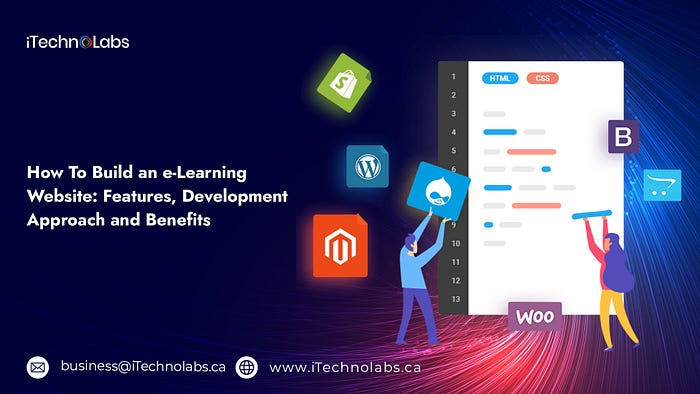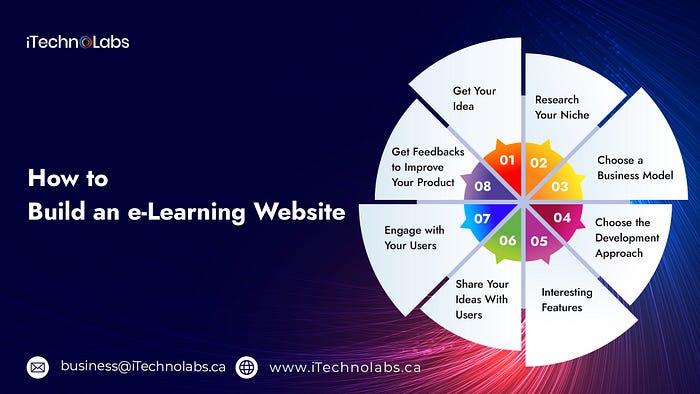How To Build an e-Learning Website: Features, Development Approach and Benefits

As a result of the COVID-19 pandemic, many colleges and schools around the world have been shut down in recent years. During that period, the entire educational system moved to online learning. E-learning platforms are used by both students and professors for their courses and studies. You want to know how to make an e-learning platform that connects students and teachers digitally.
These virtual learning platforms don’t just apply to online courses. Online courses are being used by businesses to train employees. Some reports and surveys have shown that online education will be worth $300 billion. The next question is how do you build an e-learning platform. What are the advantages of an e-education platform and what steps should you take to build a virtual learning platform?
Let’s first define eLearning platforms. E-learning, as the name suggests, is a digital teaching method that uses electronic devices like smartphones, tablets, laptops, and tablets. This method does not require students to be present in class. They can come from any location. They can also learn at their own pace. There are many learning options available today, including MOOCs (Massive Open Online Courses), video streaming platforms, and discussion forums. Let’s now take a look at how to build an e-learning platform.
How to Build an e-Learning Website

It is not an easy task to build an e-learning platform. There are many steps involved. It can be difficult to create an online education platform if you don’t have any knowledge of coding. These are the steps to creating an education platform.
1. Get Your Idea
To create a virtual learning platform you need to first come up with a solution that addresses a problem and benefits people. To find your idea, you can refer to a variety of reports and analyses. According to many reports, the global eLearning market will reach $300 billion in 2025. To be successful in the virtual learning industry, your product must be both affordable and effective. It is possible to discuss your problems with other virtual learners and come up with a solution. This will help you to better understand your target audience, and how they will react to your idea.
2. Research Your Niche
After you have created a solution for a problem, it is time to identify your niche. You can gain a better understanding of your niche by analyzing your idea. You can focus on the most popular areas such as business, entrepreneurship, health, fitness, personal growth, and arts and crafts. You can use the demographic information of your learners (age, gender, sales details, etc.) to help you. You will have an advantage as the platform evolves by getting a better understanding of your target users’ age, gender, education, and background.
This will allow you to understand your audience’s age and gender, so you can tailor your content to their needs to increase your sales and attract their attention. It is also important to consider their learning preferences and key objectives. All of these factors can help you validate your idea and find your niche.
3. Choose a Business Model
First, you need to decide on a business model before choosing a development approach. The business model will determine how your learning platform generates revenue. Below are some examples of popular business models.
- Subscription-Based — In this model, users pay a monthly or annual subscription which gives them unlimited access and content on the website.
- Affiliate Model — This business model allows you to offer integrated affiliate links in addition to the courses. You can also share the course with others. They can also earn a commission if someone uses their links to join the platform.
- Paid Certificates — In this model of business, certificates can be issued to users upon completion of courses. It has been observed that users pay for platform-verified certificates.
- Corporate Partnership — This business model allows you to work with businesses to create customized courses and then charge them accordingly.
- Paid Courses — This business model allows you to offer paid courses. The students pay for the course and then the instructor and website owner receives the money.
These are the most popular business models. These will help you increase your revenue and make your online business profitable.
4. Choose the Development Approach
Planning, frameworks, and technology are key to developing a virtual learning platform that is successful. These platforms can be developed using two methods. One is Ready-Made software, while the other is Custom Software. Let’s discuss them in more detail.
If you need to provide specialized features to large numbers of people, custom software development is the best choice. This method allows you to modify or edit something more quickly, but it also makes it easy to scale the functionality.
- Ready Made Development
Ready-Made Development is the second option. Moodle, Joomla, and Canvas are examples of ready-made or open-source software that includes basic student administration tools as well as a large number of plugins. These methods can be challenging to implement a particular feature or import custom themes. You must choose the most innovative technology and design features to make your website stand out from the rest. This will grab the attention of users and make our website stand out from other websites. In UI (User Interface), and UX (User experience), simplicity is key. It should be easy to use and navigate the eLearning website. Because mobile devices are so integral to our daily lives, the learning program must be adaptable to all devices.
Read more about Build an e-Learning Website
